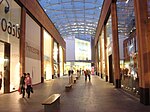Exeter underground passages
13th-century establishments in EnglandTunnels in DevonUnited Kingdom stubs

The Exeter underground passages are a scheduled monument in the city of Exeter in the United Kingdom. They were part of the city's medieval water supply system. The earliest of the tunnels dates to the 13th century. Guided tours of the tunnels occur throughout the year.
Excerpt from the Wikipedia article Exeter underground passages (License: CC BY-SA 3.0, Authors, Images).Exeter underground passages
Eastgate, Exeter Newtown
Geographical coordinates (GPS) Address Phone number Website Nearby Places Show on map
Geographical coordinates (GPS)
| Latitude | Longitude |
|---|---|
| N 50.7252 ° | E -3.5277 ° |
Address
Hotel Chocolat
Eastgate 7
EX1 1GB Exeter, Newtown
England, United Kingdom
Open on Google Maps








